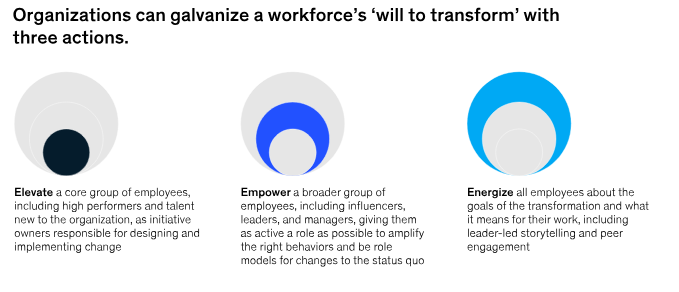Framework 188 The 3 Es (Elevate, Empower and Energise)
Introduction
This framework is tapping into the human side of change, ie an organisation's collective energy.
It focuses on 'will', ie people's will to change for the better
"... along with building critical skills, executing with rigour, setting a holistic aspiration......are far more likely to outperform their peers..."
Dominic Skerritt et al, 2024
It is a way to get staff positively involved in the change by:
- elevating
- empowering
- energising
(see diagram below)

(source: Dominic Skerrit et al, 2024)
More details
1. Elevate (the more employees actively involved initially in the design stage the change initiative onwards, the greater the chance of success. At least 7% of employees, ie especially the informal leaders, need to be actively involved in the change initiative, yet most organisations only had around 2%. Some conditions to help achieve staff involvement include
"...inspirational leaders, employee innovation, talent employment, talent acquisition, and healthy working norm..."
Dominic Skerritt et al, 2024
- leading to inspire (senior management need to focus on making work more meaningful and showing appreciation to help inspire and motivate staff; this involves investing time and effort into changing staff mindset from the start of the change initiative
"...changing employees mindset at the start are four times more likely to have a successful change than those who didn't change their mindset..."
Dominic Skerritt et al, 2024
Senior management have to 'walk the talk', ie change their own behaviours to adapt to the goals of transformation; staff will notice and react negatively to the change initiative if senior management are not 'walking the talk'.)
- encouraging employees across job levels to innovate (some of the best ideas come from employees who are closest to the customer; senior managers need to actively listen and act on recommendations from all levels of the organisation.)
- deploying talent where it is needed most (allocate talent and resources to the most critical roles; research shows
"...that one of the top three predictors of successful value retention is whether an organisation allocates its top talent to its highest-value initiatives..."
Dominic Skerritt et al, 2024
This requires understanding where value is generated and who has the expertise to handle it.)
- attracting the best external talent (hiring the most qualified people increases the likelihood of ownership of change initiatives:
"...Transformations require energy and fresh ideas, as well as a willingness to challenge the status quo . The combination of talent new to the organisation and employees with the knowledge and how to navigate the enterprise ensures that the transformation reflects the will, innovative energy, and capacity for change..."
Dominic Skerritt et al, 2024
Knowing when, what, where, etc help is needed can help create data-backed decisions about where to allocate talent.)
- creating sustainable conditions (need to create sustainable work conditions and norms; realise that in transformation roles people will take on and responsibilities with the leadership providing the expectations of how this added work is to be conducted.)
2. Empower a broad coalition of change leaders to embody new ways of thinking and work (once a core group of employees is established, efforts need to turn to empowering a broader group as role models to activate others; these change leaders, influences, informal leaders, etc
"...play are visible role in shaping and amplifying the behaviours that enhance organisational performance while counteracting behaviours that get in the way of success...... they should also be viewed as thought partners who provide feedback and support to senior leaders and employees alike......empower employees to be bold, take risks, and shake-up ingrained workplace norms and rituals..."
Dominic Skerritt et al, 2024
Ideally around 25% of the organisation is needed 'on side' to help create a tipping point that can shift the entire organisation's mindsets and behaviours.)
3. Energise all employees to transform (much energy is required to imagine a new future, to find new solutions to challenges and do things differently; this requires senior management
"...to inspire and energise at scale, which is different from giving orders from the top and expecting they'll be followed..."
Dominic Skerritt et al, 2024
Communication needs to be inspirational and encourage entire organisation to act and follow the new direction; this involves helping staff understand why the transformation is very important and how to move the organisation in the right direction.
"... It starts with why: as leaders begin to implement changes, employees across levels should be given a clear view of where the organisation is going, how it will get there, and why it's all worth it - for employees, customers, shareholders, and other stakeholders......this means that leaders must develop a clear, motivating case or change in language that is clear to everyone..."
Dominic Skerritt et al, 2024
This is different from the traditional top-down cascade, as staff want to know what the change initiative means to them, ie reduce any perception gap between senior management and staff so that change leaders are able to answer the difficult questions and handle any confusion.
One skill is storytelling, ie use personal narratives that are relevant to the different stakeholders.
"...The goal is to foster a thousand meaningful conversations about change......this approach includes fostering two-way dialogue and peer engagement to help employees understand their roles in achieving a lasting transformation......to ignite employee engagement......by deliberately communicating with, not at, their teams..."
Dominic Skerritt et al, 2024
NB For staff, their immediate boss is their main contact on any change initiative; these bosses must be champions of the change and have the answers to their staffs' concerns.
The use of incentive programs can help in this situation.)
